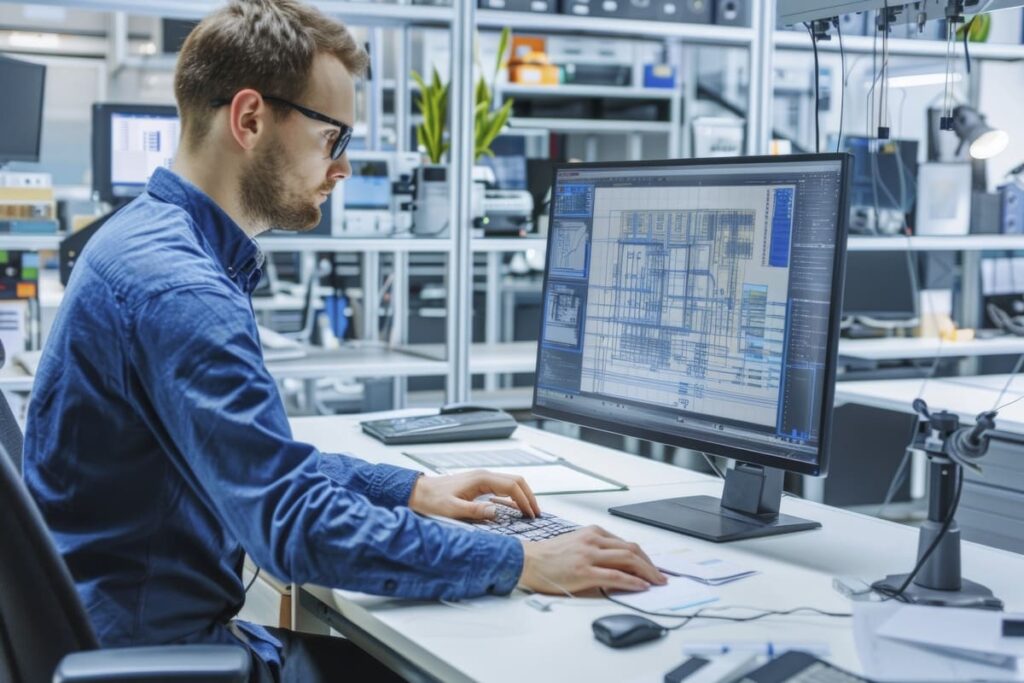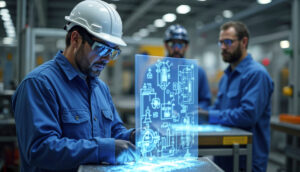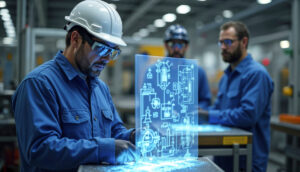Digital Fabrication 2025 refers to the cutting-edge use of digital technology – especially artificial intelligence (AI) and robotics – in construction manufacturing and assembly. In this context, it means automating the fabrication of building components (and even entire structures) through computer-guided processes. Traditional construction methods are being augmented or replaced by robotic arms, automated machines, and AI-driven software that can plan, monitor, and optimize the building process from design to assembly. The goal is to bring the efficiency and precision of factory manufacturing to the construction site, bridging the gap between digital building models and physical construction.
AI and robotics are revolutionizing construction workflows by taking on labor-intensive or highly precise tasks that were once done manually. Robots can execute repetitive or heavy jobs (like laying concrete or assembling modules) with speed and accuracy, while AI systems analyze data to make real-time decisions and predictions. The result is a transformation in how buildings are made: increased efficiency, improved precision, enhanced safety, and often better sustainability (through reduced waste and optimized resource use). The sections below explore key trends in Digital Fabrication 2025 – from 3D-printed concrete walls to intelligent scheduling – with real-world examples illustrating the impact of these technologies on construction.
Table of Contents
Key Trends in Digital Fabrication for Construction
Robotic 3D Concrete Printing
One of the most headline-grabbing innovations is robotic 3D concrete printing. Instead of traditional formwork and manual pouring, large industrial robots or gantry printers extrude concrete layer by layer to create walls and structural elements directly from a digital model. This technique, also known as 3D Construction Printing (3DCP), allows complex shapes and curved structures to be fabricated with minimal human intervention
Companies like Apis Cor have pioneered this technology, using robotic arms to print entire small houses on-site. In one project, Apis Cor’s mobile 3D printer constructed a 38-square-meter house in Russia in just 24 hours of machine printing time – something nearly impossible with conventional methods. Such robotic printers ensure uniform layering and can operate continuously, which reduces construction time and labor costs.
Beyond pilot projects, 3D concrete printing is scaling up. Robotic printers have been used to fabricate components for commercial buildings and even bridges. For instance, robots from Contour Crafting can print structural walls and entire building sections directly on the construction site. This not only accelerates the build process but also cuts down material waste by using precise quantities of concrete for each design.
The precision is enhanced by AI algorithms that adjust the mix and placement based on sensor feedback, ensuring consistent quality in each layer. Early results show that 3D printing can produce structures with fewer errors (since the process follows the exact digital blueprint), and it opens new architectural possibilities (like complex geometries) that would be expensive or impractical to achieve with traditional formwork.
Key Benefits of Robotic 3D Printing:
-
Speed: Continuous operation and automated layering drastically shorten construction timelines. Entire building shells can be printed in days rather than weeks.
-
Labor Reduction: Fewer workers are needed on-site for tasks like masonry or formwork, which helps address labor shortages and reduces safety risks.
-
Design Freedom: Curved and intricate designs are easier to achieve since the printer follows a CAD model directly, without custom molds.
-
Reduced Waste: Precise extrusion means using only the material required, minimizing waste and the carbon footprint of construction.
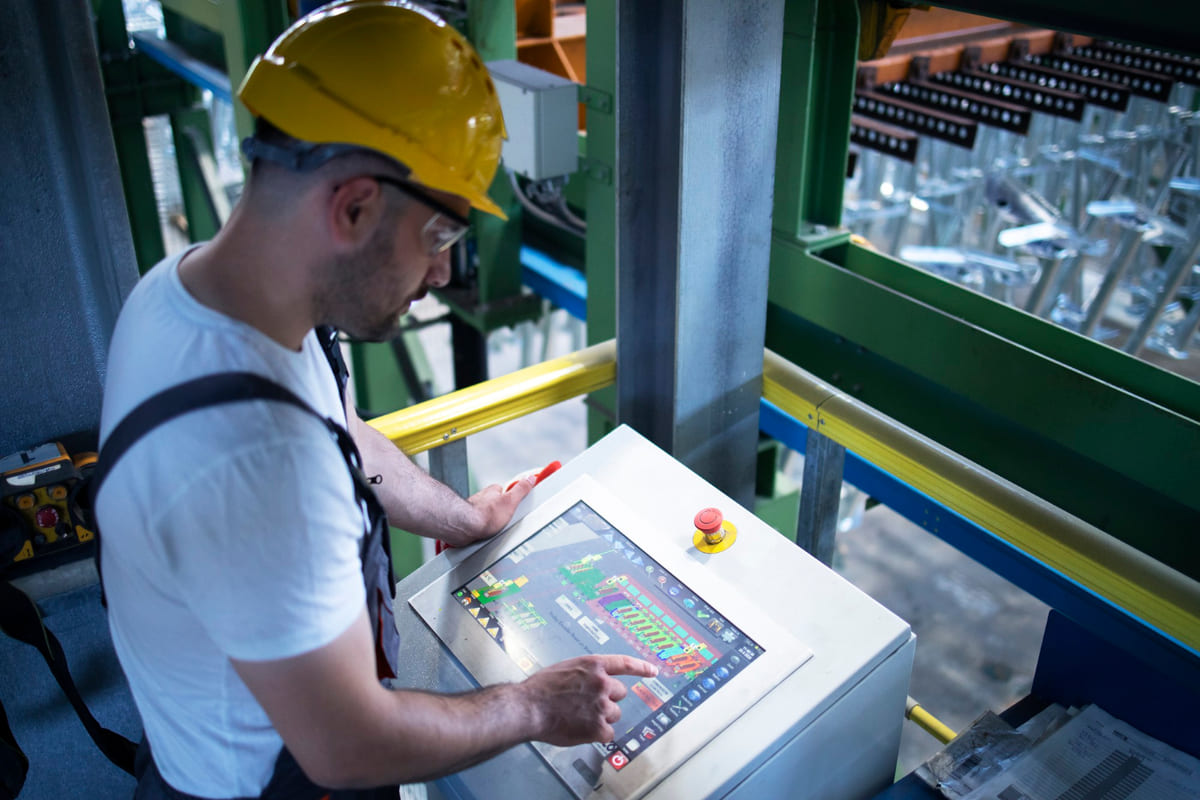
AI-Powered Modular Assembly
Modular construction – where large sections of a building are prefabricated in factories – benefits greatly from AI and robotics. In a factory setting, robots can perform assembly-line construction of modules (such as apartment units or wall panels) under controlled conditions. This is already practiced by companies like Sekisui House in Japan, which operates fully automated housing factories where robots handle everything from assembling room modules to applying finishes, ensuring each unit is built to exact standards. Each module is produced to precise specifications, and AI vision systems perform quality checks to verify that every element aligns with the digital design.
AI systems also coordinate the numerous tasks on the modular assembly line. Intelligent scheduling algorithms assign work to robotic stations in an optimal sequence – for example, as soon as a steel frame is welded by one robot, another robotic arm can begin installing drywall or fixtures. This minimizes idle time and keeps production efficient. Such automation dramatically speeds up fabrication while maintaining consistent quality. It also improves safety, since most construction activities are moved into a controlled factory environment where robots do the heavy lifting and precision tasks.
Advantages of AI-Driven Modular Fabrication:
-
Consistent Quality: Robots repeat tasks the same way every time, ensuring that each module is built to a high standard. AI vision checks catch defects early.
-
Faster Completion: Factory automation can run 24/7. Entire apartment modules can be produced in hours or days, significantly cutting project schedules.
-
Safety and Ergonomics: Workers face fewer hazardous tasks – robots handle heavy or dangerous operations, while humans oversee from safe stations.
-
Scalability: Once an AI-driven production line is set up, increasing output is straightforward. The process is highly repeatable and can be scaled by adding more robotic stations.
Suggested article to read: Modular Construction; Everything You Need to Know in 2025
Real-Time Quality Control via Vision Systems
Maintaining quality in construction manufacturing is challenging when done by hand, but AI-powered computer vision is changing that. High-resolution cameras and sensors are now integrated into fabrication lines to continuously inspect work as it’s being done. These AI vision systems use machine learning to recognize errors or deviations from the design in real time. For example, in a modular home factory, cameras at key stations scan each panel and frame; the AI can instantly flag a misaligned beam or an improper screw placement that a human might miss. Every component – from cut lumber to welded joints – gets checked against the plan’s specifications.
Real-world deployments show the effectiveness of this approach. One off-site manufacturing facility reported using AI-controlled image processing to catch errors immediately: the system can identify dimensional inaccuracies in wall panels on the fly and even detect micro-defects in materials like cross-laminated timber that are invisible to the naked eye. If a panel is even 2 millimeters out of tolerance, the vision system alerts operators before the module proceeds to the next stage.
This instant feedback loop prevents costly rework down the line. It also optimizes material use – by catching mistakes early, pieces can often be fixed or reused instead of scrapped. AI-based quality control isn’t limited to factories; on construction sites, mobile robots or drones with cameras can autonomously patrol and compare the built structure against digital plans, spotting any deviations in real time. This ensures that assembly errors (like misaligned installations) are corrected before they become larger problems.
Capabilities of AI Vision Quality Systems:
-
Defect Detection: Automatically identify cracks, misalignments, or surface flaws as soon as they occur, using cameras and sensors instead of manual inspection.
-
Measurement Verification: Use lasers or 3D scanners to verify that dimensions of fabricated parts match the design (e.g. checking that door openings or panel lengths are exactly to spec).
-
Continuous Monitoring: 100% of production can be monitored (unlike sporadic manual checks) because AI can analyze images rapidly without fatigue.
-
Data Traceability: Every detected issue is logged, building a data set that AI can learn from to predict and preempt future quality problems.
Autonomous Rebar Bending and Placement
Structural concrete relies on steel rebar reinforcement – a tedious and physically demanding part of construction. Autonomous rebar placement is a game-changer in this area. On construction sites, robots are tackling the back-breaking task of laying out and tying rebar grids for concrete structures. A prime example is the TyBOT and IronBOT system. TyBOT is an autonomous rebar-tying robot that uses machine vision to locate rebar intersections and twist wire ties, while IronBOT is designed to lift and position heavy rebar bundles into place.
Using no special pre-programmed maps or GPS – the robot simply follows spacing requirements given by the user – IronBOT can be mobilized on a job site within hours and start placing thousands of pounds of rebar automatically. Field trials have shown impressive results: when a bridge project in Florida employed IronBOT together with TyBOT, the team placed 147,000 lbs of rebar and tied 58,000 intersections in about half the usual time, cutting the rebar installation schedule from 14 days to 7 days.
This ~50% time reduction not only accelerates the project but also frees up skilled workers to focus on other tasks. Importantly, these robots improve safety by keeping laborers out of the rebar grid (reducing trip hazards and strain) and eliminating repetitive manual tying motions.
Impacts of Rebar Automation:
-
Faster Installation: Automated rebar placement and tying significantly speed up one of the most time-consuming phases of concrete construction.
-
Labor Savings: A small crew can oversee multiple robots, allowing contractors to reallocate workers to less monotonous tasks.
-
Precision: Robotically bent and placed rebar follows design specs exactly, ensuring reinforcement is positioned where it’s needed for structural strength.
-
Safety: Reduces the risk of injuries from heavy lifting and repetitive tying; workers are exposed to fewer hazards on the rebar grid.
Robotic Finishing Tools (e.g., Plastering, Sanding, Painting)
After the structural work, tasks like plastering, sanding, and painting can be handled by specialized robots. For example, a drywall finishing robot uses machine vision to spray and sand joint compound, reducing the time to finish walls from about 5 days to 2 days. Similarly, an autonomous painting robot trialed on public housing in Singapore boosted painting productivity by up to 30%, leading to plans for deployment at roughly half of new housing projects from 2025. These finishing robots not only speed up the final stages of construction but also ensure consistent quality (uniform coats of plaster/paint) and improve safety by reducing the need for workers on ladders or scaffolds.
Productivity Gains with Finishing Robots:
-
Speed: Robots can paint or plaster large surface areas continuously, with some achieving 20–30% faster completion of finishing tasks.
-
Consistency: Automated sprayers apply materials evenly, resulting in uniform texture and color with fewer touch-ups needed.
-
Labor Efficiency: One technician can supervise a painting robot that does the work of several painters, helping address labor shortages in finishing trades.
-
Safety: Less manual work on tall ladders or scaffolds – robots can handle high or awkward spots, reducing fall risks.
Predictive Fabrication Schedules with AI
AI-driven scheduling algorithms analyze past project data and real-time updates to create predictive fabrication schedules. This means off-site production of modules and on-site assembly are coordinated in the optimal sequence. The AI essentially finds the most efficient order of tasks and adjusts on the fly if there are delays, ensuring that components arrive just in time and crews are never kept waiting. This dynamic approach also helps with risk management – the system can forecast potential delays (like weather or supply issues) and proactively reschedule tasks to keep the project on track. By smoothing out the workflow in this way, AI-based scheduling reduces downtime and helps projects stay on schedule even when unexpected changes occur.
Smart Scheduling Benefits:
-
Just-in-Time Production: Aligns factory output with site readiness so that prefabricated components arrive exactly when needed, reducing storage time and idle crews.
-
Delay Mitigation: Predictive models forecast likely delays and adjust the sequence of tasks proactively, minimizing the impact of disruptions.
-
Resource Optimization: AI optimizes the use of labor and machinery, avoiding both downtime and overallocation. This improves productivity and can lower costs.
-
Reliability: Project timelines become more dependable. The AI continuously refines the schedule and provides early warnings, making completion dates more predictable.
Digital Twins for Offsite and Onsite Synchronization
A digital twin is a virtual replica of a physical project, updated in real time with data from sensors, machines, and schedules. In construction, digital twins have become invaluable for synchronizing offsite fabrication with onsite assembly by providing a shared, up-to-date model of the project’s status. As components are fabricated in the factory, their digital counterparts are marked complete in the twin; as on-site crews or robots install elements, the twin reflects that progress. This ensures that any discrepancy between what was planned (the virtual model) and what is built is caught early.
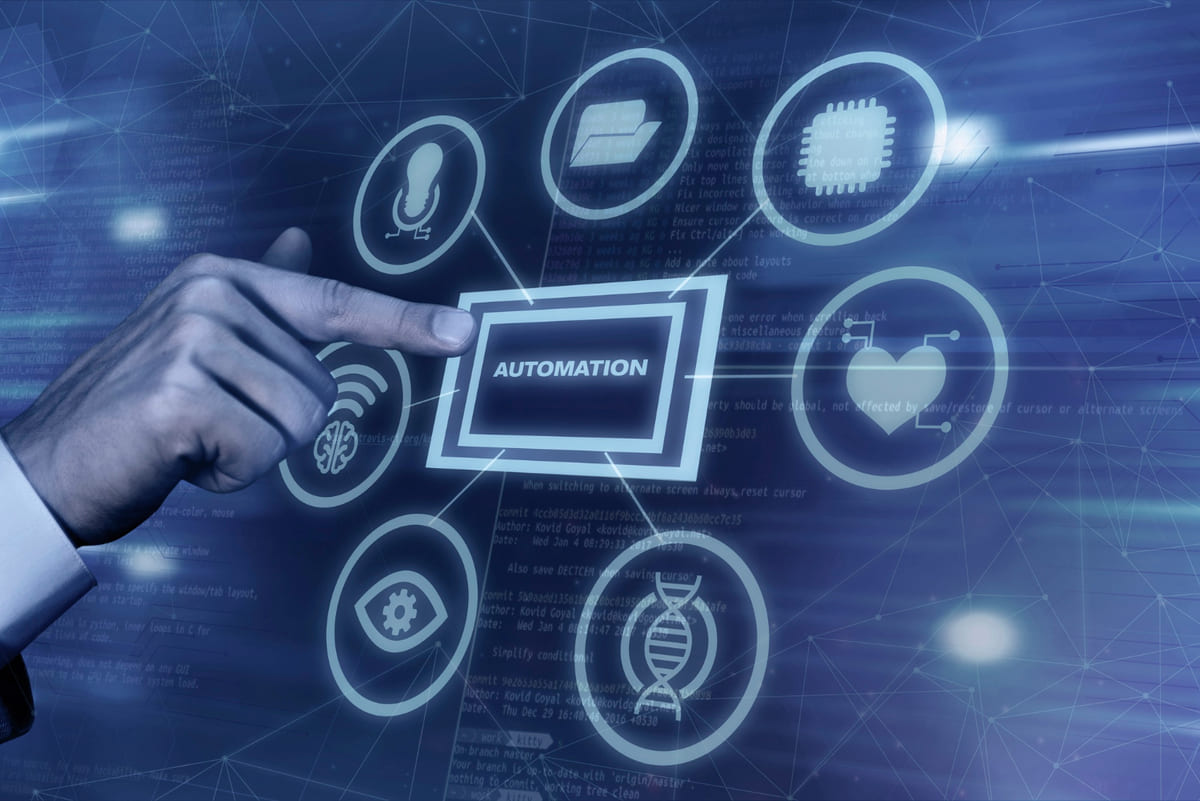
In practice, digital twins act as a coordination hub. For example, in Singapore’s Tengah town development, the housing agency integrated an AI-driven tower crane system with a live digital twin of the site. As precast concrete modules were lifted into place by the automated crane, the entire installation process was monitored through the digital twin in real time – showing exactly which piece was placed and confirming it was positioned correctly.
Such synchronization avoids errors like a prefab panel arriving out of sequence or being installed incorrectly, because the virtual model checks placement and progress before the actual component is set. Offsite and onsite teams stay in lockstep: if a design change is made or a delay occurs in one realm, the digital twin immediately reflects it and updates the plan for the other. This level of coordination leads to higher efficiency and fewer surprises during assembly, ultimately helping projects finish faster with rigorous quality control.
FAQs
How does Digital Fabrication 2025 improve efficiency in construction?
Digital Fabrication 2025 improves efficiency by automating time-consuming tasks and optimizing schedules with AI. Robots work continuously without breaks, speeding up processes like module assembly and concrete printing. AI-driven scheduling also coordinates offsite fabrication with onsite work to eliminate downtime. The net effect is faster project completion compared to traditional methods.
What technologies are central to Digital Fabrication 2025 in construction?
Key technologies include industrial robotics (for tasks such as 3D concrete printing, robotic welding, and automated assembly), AI algorithms (for planning, quality control, and real-time decision-making), and IoT sensors feeding data into digital twins. Computer vision is also central, as it enables automated quality inspection and guides robots. Together, these technologies create the seamless fabrication and assembly workflows that define Digital Fabrication 2025.
Which areas of construction benefit most from Digital Fabrication 2025?
Areas involving repetitive, labor-intensive, or precision tasks benefit greatly. For example, offsite manufacturing of modular building units is accelerated by robotics, and on-site activities like rebar installation or wall finishing see huge productivity gains from automation. Projects with complex designs also benefit, since digital fabrication easily handles intricate forms that would be hard to build manually.
Is it true that Digital Fabrication 2025 will reduce construction costs?
Yes, in many cases Digital Fabrication 2025 can reduce construction costs. By using AI to minimize waste and optimize material use, projects save on resources. Robotics can work faster and often more precisely than manual labor, reducing labor costs and rework. For instance, automated processes use only the material needed (cutting waste) and catch mistakes early, preventing costly fixes later. While there is an upfront investment in technology, the improved productivity and reduction in errors tend to lower overall project costs.
Conclusion
The landscape of construction manufacturing is rapidly evolving under the influence of AI and robotics – what we refer to as Digital Fabrication 2025. From 3D-printed concrete homes to AI-orchestrated assembly lines, these technologies are increasing efficiency, precision, and sustainability in building projects. We see structures going up faster than before, with robots working tirelessly on tasks like printing walls, tying rebar, or painting surfaces.
Quality is improved because AI systems catch errors in real time and ensure each component meets specifications. Safety and labor conditions are better as machines take over dangerous or repetitive work. Moreover, intelligent scheduling and digital twins mean that offsite fabrication and onsite construction proceed in sync, eliminating costly delays. In summary, Digital Fabrication 2025 is not a distant future vision – it is already here on leading projects, and it is redefining how we design and build the next generation of buildings.
Resources:
- Channel NewsAsia. (2024). About half of new BTO projects to use more robots for painting works from 2025.
- Archinect News. (2023). Autonomous construction robot IronBOT launched to reduce rebar installation times.
- Highways Today. (2024). The Rise of Construction Robots in 2024. Available at:
- Modular Building Institute. (2024). The Potential and Possibilities of AI for Offsite.
- Offsite Innovators. (2023). AI-Controlled Image Processing: A Game Changer for Modular Home Factories.
- Designboom. (2017). Apis Cor 3D Prints a House On-Site in 24 Hours.
For all the pictures: Freepik
Suggested article for reading:
4 Types of Fire Detection Systems and Where to Use Each One in 2025
Top 7 Sustainable Digital Fabrication Innovations Leading the Green Revolution
5 Tips on Choosing a Construction Company for Residential and Commercial Projects
8 Key Features of Next-Gen Fire Detection Systems
10 Digital Fabrication Trends Shaping the Future of Smart Manufacturing

